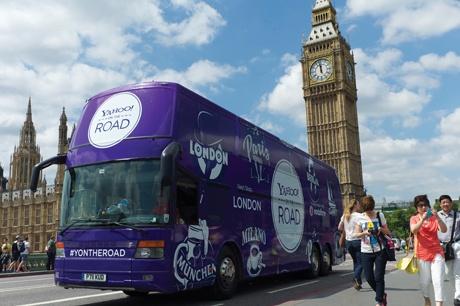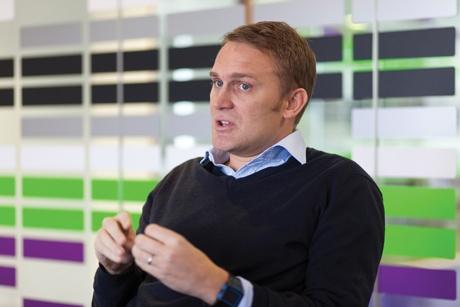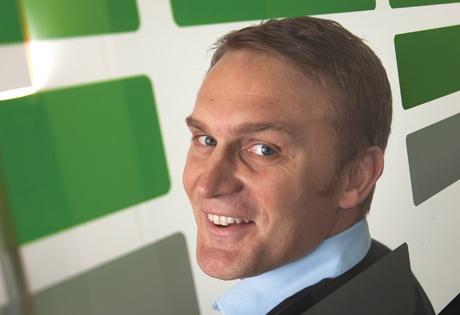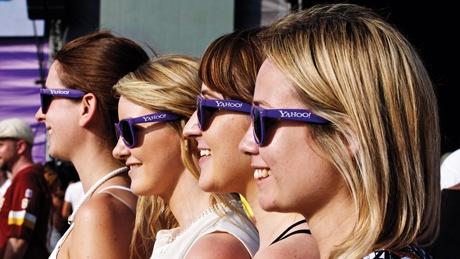Profile: Yahoo's Robert Bridge
Yahoo vice president of international marketing Robert Bridge has helped steer the company through a turbulent few years and it is now aiming to turn a corner thanks to a strategy focusing on products, younger users and native advertising.
When Yahoo[1]’s Robert Bridge was promoted to vice-president of international marketing, he was soon to discover chief executive Marissa Mayer[2] ’s keen involvement in brand strategy, saying that she is closer to marketing than any other CEO he has known.
“I have worked with other CEOs, many of whom are in smaller business and are always very interested in the marketing side of the business, but when you get to some of the bigger businesses it seems to be that you get less time and less interaction.”
Following his promotion from director to vice-president last month, Bridge now has access to ‘town hall’ meetings every month when he hears from Mayer directly, giving him and the rest of the team a sense on confidence they have never had before.
He explains that she interacts with staff across the board, from PR, product, people to sales staff. He says: “Her ability to understand every aspect of the business and have an opinion on it is just staggering.”
Yahoo has had a chequered history of late. Before Mayer joined from Google in July 2012, it had had three CEOs in as many years and was losing out to rival search engines and social networking sites. It had also laid off 2,000 people in an attempt to become a ‘bold, new Yahoo’. Since Mayer started, she has concentrated on its products and has made significant acquisitions including blogging site Tumblr for $1.1bn, as well as redesigning its logo[3] in-house.
One of the hardest things has been to continually change mindset and strategy in line with corporate policy
Bridge, who has been at the company for four years, oversees all the marketing in every region outside the US - a total of 67 countries across EMEA, Latin America, India, South East Asia and Canada - a role that has been fundamental in communicating events, new product launches and acquisitions of companies and talent under the stewardship of Mayer. The EMEA region takes up 60 per cent of his time, with the UK a key part of that.
His working day might include meeting clients in European cities about partnerships before catching up with his teams, flying back to London for a town hall meeting before spending time with his children, followed by another hour or two working, with calls to the US scheduled in after dinner.
Since Mayer took hold of the reins, Yahoo has been more product focused, for example there is a revamped Yahoo Mail, a new Flickr[4] experience on mobile[5] and desktop, an update of the logo[6] , a redesigned fantasy football app, increased content on celebrity site omg! and the sponsorship of music festival Wireless this year (see box out).
Connect these strategic dots from the past 12 months and the plan becomes clearer. Target younger consumers and concentrate on a variety of products and content, rather than just search, to differentiate from competitors. Music is becoming a key focus for the company.

“We used music as a passion point for the younger demographic and showed that Yahoo has a good place there,” says Bridge. “We had a lot of music content and celebrity-driven content, which fits very nicely with this.” Yahoo’s VIP section at this year’s Wireless festival hosted and interviewed celebrities the content of which were uploaded to the omg! Site. People visiting the site were able to watch music content from the previous day (see case study[7]).
In line with targeting younger people and as part of its approach towards more marketing partnerships, Yahoo live-streamed the red carpet event at One Direction’s film premiere for This is Us, clocking up 1.5 million views.
Product upgrade wobbles
However, it has not been a smooth ride for certain upgrades to the Yahoo product portfolio. Flickr customers complained about the usability and loss of community feel when the site upgraded its layout in May, and took to the site’s help pages to voice their grievances.
The upgrade of Yahoo Mail received a similar reaction. Users complained it looked like Google’s Gmail but without its functionality as many features were removed for the redesign, for example being able to separate search pages from email pages via tabs, which Gmail does not offer.
Changes are inevitable under new management and Bridge believes that Yahoo Mail is still “best in class”. He says: “I would say that, but I’m honest enough to say that it perhaps wasn’t when I first joined Yahoo.
“Whenever you change something that 350 million people use every month there is always going to be some people that don’t want the change. We believe that it’s the right move - it’s simpler and faster. All the research [we did], in terms of the speed of use and the simplicity, drove us to make the changes.”
Acquisitions
Having acquired Tumblr[8], there could be potential for further backlash dependant on the plans for the blogging site - but at the moment Yahoo is sticking to its promise ‘not to screw it up’.
The company has had “very little dealings with them yet and they are definitely being kept at arm’s length as Marissa promised”, but according to Bridge the two companies are also increasingly having conversations so 2014 will see the two working more closely together.
An announcement of the acquisition on Mayer’s blog stated: “Tumblr is incredibly special and has a great thing going. We will operate Tumblr independently. David Karp will remain CEO. The product roadmap, their team, their wit and irreverence will all remain the same as will their mission to empower creators to make their best work and get it in front of the audience they deserve. Yahoo will help Tumblr get even better, faster.”

It’s a statement that Yahoo has remained true to but both Bridge and Mayer believe that it will become a revenue driver for the business since the company is receiving queries about advertising formats for the site.
Bridge says: “I hope it’s going to be a revenue driver, I think Marissa hopes that too. [Tumblr] has amazing advertising and brand opportunities. If you look at the user-generated content there and you look at where our homepage is going with this infinite stream of content and all our media properties, there are some amazing synergies.
”Tumblr also offers amazing opportunities to start pulling that content into Yahoo and for Yahoo on the flip side to use some of its technology within Tumblr.”
It is not just the consumer side that is important. When Bridge talks to advertisers one of their many questions is ‘how do I engage with Tumblr?’ and the interest is there because the blogging site has engaged a young audience.
Bigger companies like Tumblr will take Yahoo longer to integrate into its business and is “more of a challenge” compared to smaller businesses. For example, when Yahoo bought content app Summly[9] in March this year for around $30m, the integration into the Yahoo app took only three weeks.
Despite all the activity around its products and events, Yahoo’s Q3 reports show that revenues are down by 5 per cent[10] year-on-year but Bridge does not believe this is something the company should worry about.
He says: “As with any ambitious management team you want to do better than that and Marissa has said it’s our goal to grow and we are in a high-growth industry.”
That growth is tied up in Mayer’s ‘four pillar’ strategy of people, products, traffic and revenue. The idea is that you cannot create great products without people, so you have to hire great people; you then create great products, which users want to engage with, and that in turn drives traffic, which finally leads to revenue.
“In the fourth quarter and into 2014, we want to see that growth happening but because the strategy was always about ‘lets get the people in, lets improve the products, lets drive traffic’, again I think that the revenue will come.
“I don’t think there is worry, there is ambition and desire to tick that final box and get cracking with that.”
If the revenue, new business integrations and user challenges are not enough, Yahoo is also up against the behemoth that is Google[11] . YouGov’s Brand Index ranks Yahoo at 17, compared to Google’s ranking at 4, but Microsoft’s Bing at 32. Yahoo’s ranking has not changed year-on-year, but Google’s has slipped by two places.
Native ads give the opportunity to be contextual around content that’s relevant and behavioural
On a personal level, Bridge says that “as an Englishman we all like the underdog spirit and we’re in the world of some really amazing competitors and I like that feeling of being part of a business that’s on a different curve.”
On a professional level, Yahoo aims to differentiate itself from its competitors, both from the business-to-business and business-to-consumer perspective. From the advertising and agency perspective it considers itself a one-stop shop, with its display advertising, homepage takeovers and mail logins.
Yahoo also has search, and programmatic display - where buying and selling display advertising is automated using real-time bidding - via Right Media, which it owns. It is also developing more mobile formats and has launched native advertising on Yahoo’s US website, where commercial content is presented in a similar way to editorial content in the news stream on the homepage.
It is similar on the consumer side, in that Yahoo considers its portfolio of products, including mail, sports, weather, news, and celebrity as a differentiator.
Before Mayer joined Yahoo, Bridge admits that the company environment was challenging . Having several CEOs in a short time meant the business lacked focus.
“As a senior leader, you have to buy into the strategy that comes from the CEO,” he says. “You have to interpret that yourself and then drive that through everything that you do and make sure that your teams are aligned behind it.
“One of the most difficult things during those times was to continuously have to change your mind-set and realign your strategy to the corporate strategy and reinvigorate the teams through that period. I found that tough but thankfully we came out in the end with a strategy and a direction.”
Daily habits
That direction has seen the site work around “daily digital habits”. Yahoo’s research shows the ways people get and use information every day are mostly online, for example by accessing its mail, news and weather, photos, social media and sports coverage.

From a mobile perspective, which slightly differs from how people use desktop computers, taking photos, news, weather, and finance are key daily habits. In general, digital habits also include fantasy football, which is a key engagement driver for Yahoo, as well as email
“That’s where the [daily digital habits] strategy was born,” Bridge adds. “Our goal is to create these products that really inspire and delight on a daily basis. It’s something that has changed in our business. If I sat with you in those days of 2012 and told you how many products we had launched or how often they had been iterated, it would have been difficult.”
Although it is Yahoo’s strategy and also its mission statement to ‘make the world’s daily habits inspiring and entertaining by creating highly personalised experiences’, it is yet to be proved that end-users perceive the site and its products in that way and whether that strategy and goal resonates with consumers.
Bridge says that the honest answer is that they have still got a way to go on it and that one of the challenges from a marketing perspective is to make users aware. “So many users experience Yahoo products, for example in the UK we have 26 million users a month and globally it’s 800 million, but it’s about making them aware that they are using Yahoo Answers, going to Flickr to upload their photos, going to search or homepage, using the mail.
“One of the challenges is to tie that all together and make sure that people are aware that Yahoo is providing them with so many of these experiences.”
A more recent challenge has been allegations that Yahoo’s and Google’s servers have been subject to interception by the US National Security Agency (NSA).
The company said at the time: “We have strict controls in place to protect the security of our data centres, and we have not given access to our data centres to the NSA or to any other government agency.”
Bridge says: “From a marketing viewpoint, what we try and do is from the customer care perspective. If people have questions, we need to make sure that we are as responsible as possible on either our social channels or on the phone. It’s about visibility and transparency.”
Bridge believes the biggest change that he has seen in the business and the industry overall is the growing use of mobile and adds that how marketers react to it is vital. “As marketers, things had always got bigger and better, bigger and brighter [including] out-of-home [marketing], bigger television screens and better laptops - and then suddenly they say [we have to] market on a four- or five-inch screen, and that’s really difficult.
“But that’s where some of these native advertising formats will work in a contextual environment and on multi-device.” The future is very much around native advertising, which Bridge believes has a good synergy with search and performance display. Yahoo launched native ads in the US around five months ago and it has been “going really well”. The format was launched in the UK last week.[12]
Bridge says: “What I like about native ads is that you have the opportunity to be contextual. We have been talking about branded content for a long time in the industry but the native ads have the opportunity to be both contextual - around content that is relevant - and also behavioural. [Brands] can use the personalisation engine that underpins all of our content as well as our advertising to deliver both personalised messages in a contextual environment.
For Yahoo and Bridge, the focus for 2014 will be these new ad formats as well as a continued focus on music and sports, with the Winter Olympics and World Cup in Brazil as a ‘passion point’, and segmenting becoming more tactical in targeting the younger 18 to 34 demographic.
The continued drive in mobile will include measuring downloads of the products, improving the tracking and understanding of mobile with end-to-end user flows - from the moment Yahoo runs an ad promoting its products to the moment it gets a download to how much that product is used.
Bridge’s biggest challenge is working with the younger demographics because what they do changes so quickly, he says. “Thankfully, we have the products coming online that I can now use to go to market with.”
Yahoo by numbers
800 million
monthly unique users worldwide, a 20 per cent increase in the 15 months to September 2013
60
these users are in 60 countries
390 million
monthly mobile users worldwide, 15 per cent growth in Q2
Case study

Wireless
Over 180,000 festival-goers entered the Queen Elizabeth Olympic Park in London this July for three days of music, including headline performances by Jay-Z and Justin Timberlake. Yahoo’s sponsorship enabled millions of people around the world to watch the action on Yahoo’s live stream from the festival.
The event had a Yahoo-branded main stage, flags, giant orbs, 600 glowing beach balls in the crowd, and a ’Yahoo on the Road’ bus to entertain the crowds as well as a Flickr photo booth where people could upload their festival experiences to a photostream.
The Yahoo VIP lounge included The X Factor judge Nicole Scherzinger, Game of Thrones actress Oona Chaplin, Tottenham Hotspurs striker Jermain Defoe and stars from reality-TV shows Made in Chelsea and The Only Way is Essex.
The VIP lounge was where Yahoo’s celebrity site omg! conducted backstage interviews with artists such as Snoop Dogg, Rita Ora, John Legend and Tinie Tempah. Yahoo employees also immersed themselves into the crowd by performing challenges set by fans at home through Twitter using the hashtag #omgonamission.
The company claims to have seen increases in brand perception and equity scores among the 16- to 24-year-old group, as well as an increase in its net promoter score.
Robert Bridge: CV
October 2013 – present: Vice-president, head of international marketing, Yahoo
March 2013 – October 2013: Senior director, head of international marketing, Yahoo
January 2012 – February 2013: Senior director, head of marketing EMEA, Yahoo
May 2010 – January 2012: B2B marketing director EMEA, Yahoo
October 2007 – May 2010: Global marketing director, Phorm
June 2003 – September 2007: VP marketing and business development, Transit Television Network
January 2001 – May 2003: Strategic development manager, Telegraph Group
April 2000 – December 2000: Business development analyst, Firstmark Communications
References
- ^ Yahoo (www.marketingweek.co.uk)
- ^ chief executive Marissa Mayer (www.marketingweek.co.uk)
- ^ logo (www.marketingweek.co.uk)
- ^ Flickr (www.marketingweek.co.uk)
- ^ mobile (www.marketingweek.co.uk)
- ^ an update of the logo (www.marketingweek.co.uk)
- ^ see case study (www.marketingweek.co.uk)
- ^ Tumblr (www.marketingweek.co.uk)
- ^ Summly (www.marketingweek.co.uk)
- ^ revenues are down by 5 per cent (www.marketingweek.co.uk)
- ^ Google (www.marketingweek.co.uk)
- ^ launched in the UK last week. (www.marketingweek.co.uk)









